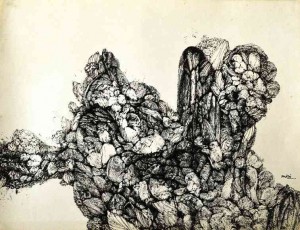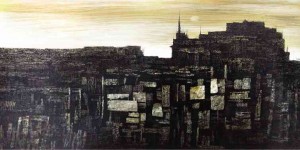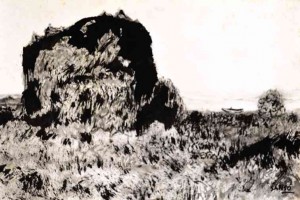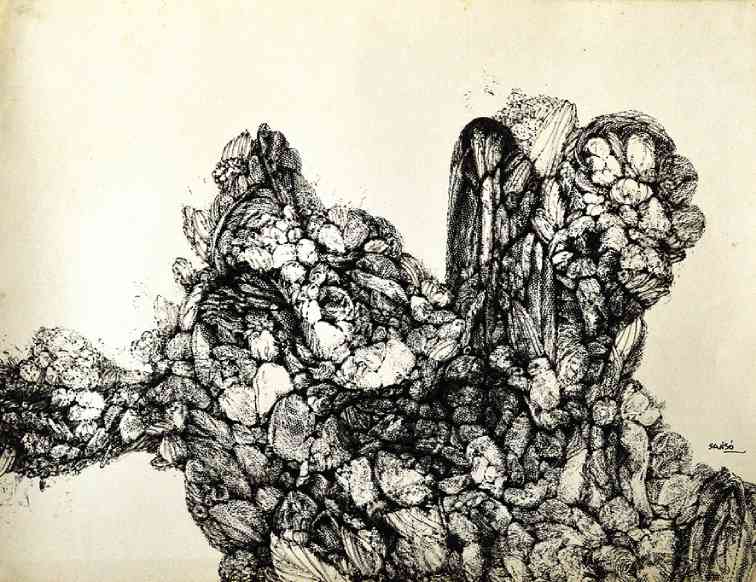
There are times when it becomes inevitable to compare Expressionist maestro Juvenal Sansó with Pablo Picasso.
They both trace their heritage to Catalonia. Sansó was born there, while Picasso moved there as a boy in 1895.
Both spent a considerable part of their careers in Paris. And they both approached their practice in the same intellectual way.
“If the lines and forms rhyme and become animated, it’s like a poem,” Picasso once said, describing the art of painting in black and white.
Three paintings in particular demonstrate Picasso’s capability in monochrome: “Guernica” (1937), “The Charnel House” (1944-45); and a variation on Eugene Delacroix’s “Women of Algiers” (1954-55). In these works, Picasso reveled in the lyrical quality, using monochrome to emphasize form.
Similarly, Sansó’s works in black and white jettison color as a distracting element, allowing other components to come forward. It is a highly considered and thoughtful method, one that the painter manages with seeming ease.
Sansó is more than a Cubist. His expansive oeuvre, traversing several decades of work with little sign of slowing down, demonstrates his range of preoccupations.

He is also, in many respects, a Philippine artist. Growing up in Manila, studying under National Artists Fernando Amorsolo and Guillermo Tolentino, and sharing in the pain of World War II, Sansó absorbed many techniques and influences from his own jarring experiences. From landscapes to prints to abstractions, Sansó is an artistic polymath.
Purest manifestation
It is his black-and-white works we can trace the lineage of great modernists—an Expressionist modus that maximizes sparseness to great effect. It is precisely within this framework that one should view the works Sansó is unveiling in an exhibit at Galerie Joaquin on Nov. 20-Dec. 2.
“Sansó: Black and White” puts together the seminal monochrome works of this artist in an exhibit to cap an eventful art year.
Sansó’s black-and-white works rank among the purest manifestation of his Expressionist sensibilities. Although faced with the Herculean task of working with a sparseness of colors, the works still provide enough information for viewers to recreate and interpret reality with their own imagination. Such is the skill that defines Sansó as one of the truly great Modernists today.

With his usual frenetic strokes and bold gestural lines, he is armed only with the chosen minimal colors of white, black and its subtleties of tones in gray. Yet the result is a visual opus. It successfully extracts emotional, psychological and cerebral reactions from the viewer.
Highly imaginative
Each of the works is excruciatingly detailed. The landscapes are highly imaginative interpretations of vistas and panoramas which Sansó has seen. These include vistas of the 24 summers he spent in Brittany, France, 1960-1984; his early years as a student visiting the coastlines of Batangas; and the rocks and rivers in Montalban where the Sansó family evacuated during the war.

Also included are composite memories of the coastlines of the United Kingdom, Ireland, and New England; and the places the artist visited during his younger years, wherever wanderlust took him.
The floral paintings are lyrical and poetic, succinctly capturing the artist’s five-and-half decades-long enchantment with the subject.
Sansó was given the Presidential Medal of Merit by the Philippine government for his contributions to Philippine art. He has been knighted by Spain and France.
Galerie Joaquin is at 371 P. Guevarra St. and Montessori Lane, Addition Hills, San Juan City. Call 7239418, e-mail [email protected].













































